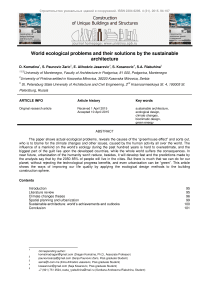World ecological problems and their solutions by the sustainable architecture
Автор: Komatina Dragan, Paunovic Zaric Sanja, Alihodzic Jasarevic Ema, Kosanovic Saja, Riabuhina Svetlana Andreevna
Журнал: Строительство уникальных зданий и сооружений @unistroy
Статья в выпуске: 4 (31), 2015 года.
Бесплатный доступ
The paper shows actual ecological problems, reveals the causes of the “greenhouse effect” and sorts out, who is to blame for the climate changes and other issues, caused by the human activity all over the world. The influence of a mankind on the world’s ecology during the past hundred years is hard to overestimate, and the biggest part of the guilt lies upon the developed countries, while the whole world suffers the consequences. In near future, urbanization of the humanity won’t reduce, besides, it will develop fast and the predictions made by the analysts say that by the 2050 85% of people will live in the cities. But there is much that we can do for our planet, without rejecting the technological progress benefits, and even urbanization can be “green”. This article shows the ways of improving our life quality by applying the ecological design methods to the building construction sphere
Sustainable architecture, ecological design, climate changes, bioclimatic design, green energy
Короткий адрес: https://sciup.org/14322244
IDR: 14322244 | УДК: 69.07
Текст научной статьи World ecological problems and their solutions by the sustainable architecture
Pompously announced new millennium, full of bright future, economic prosperity, technological progress has seriously shaken the humankind, at its beginning. Initial economic growth at the end of the 20th and the beginning of the 21st century did not last long, and economic collapse which end is not visible has been ongoing for the last seven years. Economies and countries are standing in front of the door of bankruptcy, one recession after another is revolving in countries, and common person is distraught, while the number of rich people is paradoxically increasing. What is going on? Where does it lead? Those questions are inevitably imposed since technological progress and industrialization took steps of “seven miles”. The rich become even richer, and the poor even more poor. The global consumption effect and larger indebtedness due to that consumption is a recommendation, while those who advocate saving and rational, realistic spending are considered as retardants of economic healing (figure 1).
We cannot, but wonder: is industrialization good? Is technological progress good? Is global knowledge good? Is global connecting good? These questions cause a headache to each conscious human nowadays. And why? Because, main reasons for high climate instability, which clearly affects the life on Earth, lie in answers to these questions. Every day on goings and visible changes by a naked eye are indicators of the fact that humankind is on the cross-road. How do we proceed in order to preserve this planet, while being only its temporary inhabitants and not owners? We must behave in accordance with that principle. What is causing this misbalance? Who is to blame? [1-9]
NATURAL EFFECT HUMAN ENHANCED EFFECT
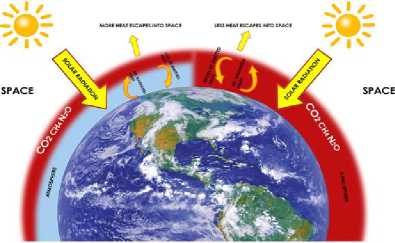
Figure 1. Gas Emission Impact to the greenhouse effect
Literature review
World’s ecological condition is a present-day problem, one of the most urgent issues of today, since 30-40 years ago such a problem didn’t even exist in scientific community. During the last couple of decades a lot of researches about climate changes have been made, including detailed tracking of a variety of different climatic indicators around the world [1-9]. The main (and very first) international document binding the countries to monitor the environmental influence of their actions is the Kyoto Protocol [10]. Many scientists are looking for new solutions that could change the situation for the better. However, it is clear that mankind should not forego the benefits of technological progress or stop increasing the rate of production, what we need are solutions that do not affect the improvement of the world’s welfare and do not adversely affect the condition of the environment at the same time.
Currently there are many innovative ideas in the fields of architecture and construction of buildings. For example, Ken Yeang, Norman Foster, Heim D., Szokolay S. V., as well as many other specialists study the prospects of using the solar energy in mass construction [11-13]. Susorova I., Perini K., Ottelé M., Perini K., Ottelé M., Fraaij ALA, Haas EM, Raiteri R. are exploring the possibility of vertical gardened facades of buildings, a promising direction, which allows not only to make the building more aesthetically pleasing and environmental-friendly, but also significantly improve the quality of thermal insulation of the building [14, 15].
The world’s revolution today is happening in the field of building materials. Professionals such as Cossu R., Rajput D., Bhagade S. S., and other drop back from the usual set of building materials and study the possibility of using waste of humanity for building purposes [16-18]. In general, sustainable architecture is a perspective and effective solution to many environmental problems, but it will be effective only when it finds application in widely applied construction. While this is mostly single projects, but the topic develops and the study of this issue has involved a large number of engineers, architects and scientists [19-29].
Climate changes theses
Life on Earth requires the balance of chemical and electromagnetic parameters, to which is the current life on the planet adjusted. In accordance with that, various scientific theories, which attempt to explain causes of climate changes occurrence taking place at planet Earth, have emerged. Presenting of those causes has led to precise division of scientific world, where two scientific theses, which aim to explain this occurrence, have distinguished.
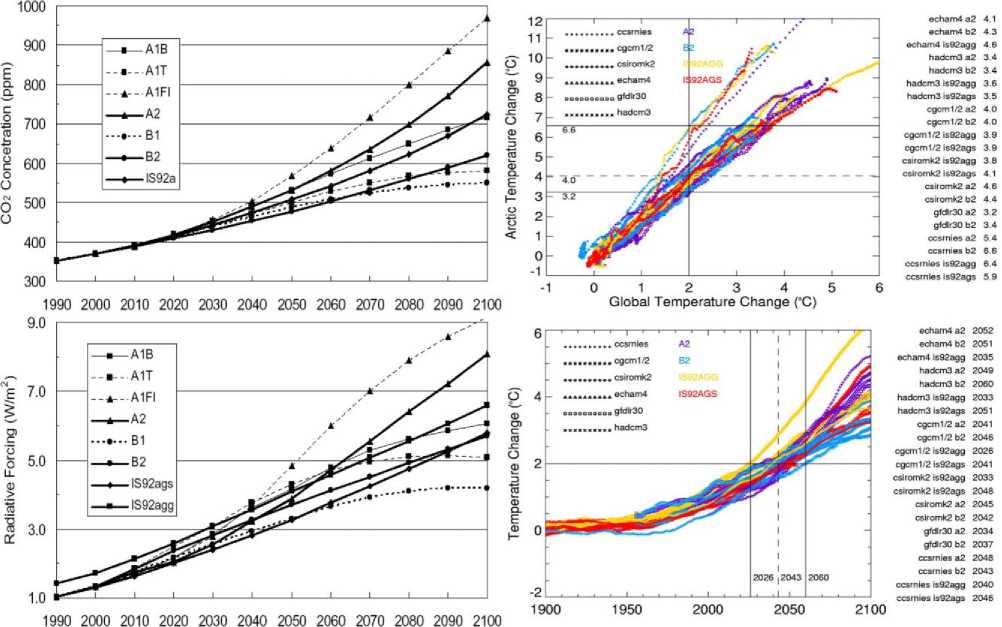
Figure 2. Movement analysis of CO2 and temperature in Earth's atmosphere [6]
First thesis is based on the claim that the main “malfeasants” of climate changes are industrially developed countries. It is manifested through their large industrial production, enormous and uncontrolled emission of harmful/greenhouse gases, especially carbon dioxide, methane and chlorofluorocarbons, as well as too large combustion of fossil fuels, especially oil/petroleum, which causes “the greenhouse effect”. This effect emerges in a manner that Earth and atmospheric molecules absorb the solar heat. The heat provided by the Sun falls on Earth, a part of the Earth absorbs it and a part of it radiates to the atmosphere. However, a part of the heat, which radiates to the atmosphere cannot find its trajectory towards the heights due to human activities that changed the atmosphere’s chemical composition and in this manner, the atmosphere is heating, instead of cooling.
It is clear that this type of temperature shifting represents a great danger for entire life on Earth. Analyses conducted by scientists that are not based on behavioral methods, but on all useful parameters taken into consideration, show that temperature increase from one to three degrees Celsius leads to cataclysmic changes on Earth, even disappearance of life. And where is the truth?
This scientific group is clearly following the thesis that individual occurrences which human initiates by his actions lead to changes of bioclimatic properties. They prove these theses by pointing to negativities of harmful gases emission into larger atmospheric layers or refrigerant emission, which create holes in ozone, which are the main controller and creator of climatic state on the planet.

Figure 3. Natural impacts (the Sun, volcanoes, shifting of tectonic plates) which affect the climate changes
In the past 130 years, the global temperature has increased for 0,6 degrees of Celsius. This global temperature increase leads to enormous impact to wide range of factors connected to climate. Levels of carbon dioxide, methane and nitrogen are increasing, mostly because of human activities. Carbon dioxide is released to the atmosphere in an alarming manner and at large extent. Ever since industrial revolution took place, people pumped great quantities of carbon dioxide, which led to increase of its concentration in even 30%. Fossil fuels combustion is, mostly, responsible for this increase.
Methane level in the atmosphere is increased in 145% since industrial revolution occurred. This increase is the result of the gas manufactured by livestock and rice fields.
Of course, the science would not be a half as advanced as it is today, if there were not explanations for each theorem which confirm it or reject it. If people continued to believe that there is nothing more than horizon, which is visible by a naked eye, we would carry on with the belief that the Earth is a flat plate. Guided by that, we are reviewing the wider spectrum of factors which affect the climate changes, and that is leading us to the other group of scientists who believe that natural forces contributed this global temperature increase.
The fact is that entire universe is a living system, which is alive due to influence of diverse forces and concentration of various gases; therefore, there is a significant number of natural activators of climate changes, such as the Sun, planetary movement, shifting of tectonic plates and continents, volcano activity.
The Sun, as a large thermo-nuclear hot ball, due to deviations in thermal, magnetic processes leads to too large emission of thermal and electromagnetic waves, which travel towards Earth and cause temperature variations. It is common that people make a mistake thinking that Sun spots/stains occurrence decreases solar radiation and its constant, while margins around black spots/stains actually discharge considerably stronger rays than average solar surface, therefore, their emergence caused by magnetic forces to which human does not have a direct influence, sends a new heat wave towards planet Earth.
Also, there is an astronomic climate theory by Milenkovic which mathematically explains that climate change on Earth is conditioned by changes in Earth’s revolving in regard to the Sun, which reflects through the change of poles and the change in distance of Earth from the Sun. This change effect has its one-year cycle of repetition, causing the climate change.
The issue gravity of both theses is clear, and the danger is great. It is more than obvious that strong financial lobbies create a widely accepted understanding of bioclimatic change issue depending on conditions on the “field”, using the theses of “ordered scientists” and strong media campaign along with “ordered journalists” and control of politicians. Due to that, one and the other thesis are being placed which represents the preparation for certain financial activity, and all with the aim of economic benefit increase. However, the truth for common human is somewhere in between. It is clear that the climate is changing, both through its shifting in space, and through its shifting through time.
Causes initiated by man, can be controlled, suppressed and generated by man. That is the manner in which The Kyoto Protocol (December 11, 1997) on remission of harmful/greenhouse gases, originated. Great economic powers came to an agreement regarding limitations of harmful/greenhouse gases emission, but that agreement has been waiting for its adoption in local parliaments for years. It was officially put in effect in 2005 when Russia adopted it. One of the main polluters, USA was the last in line to adopt it along with precise correction, while China (which ratified it) has a poor practice of its application, because it, along with the USA, represents one of the main planetary polluters.
What is the purpose of negotiations and the agreement adoption if there is no desire to change? It is the fact that the economically most developed countries (G8) form almost 2/5 of human population, and other 188 countries or remaining 3/5 of the planet’s humankind suffer through their imperious treatment of common space. The last decision/resolution that president of the USA, made on 02.09.2011 is renouncement on regulations on harmful/greenhouse gases emission, due to poor economic situation and pressure of large capital, explaining that those regulations ruin and decrease the number of work places and production. Guided by this attitude, other highly developed countries have, but not directly, followed this practice. Human is the only being on this planet who does not want to adjust to life of the planet itself, but on the contrary, by undertaking of actions, he desires to affect it, by using technology guided by practical economic reasons.
What is relevant for developing countries is that, whether in rapid or slow motion, changes in climate will, logically, have a greater economic impact on poor countries, rather than rich countries. Two facts lead to this conclusion. First of all, poor countries are forced to live “on the edge” of survival and have significantly less capacity to adjust to changes. If we make a comparison between the flood caused by Mississippi river in 1993 and various great floods which took place in developing countries, such as Bangladesh, we can make a conclusion that, even though Mississippi floods were very severe, USA were able to adjust to them with exceptional legerity. With a small number of casualties, the support came from all parts of the country, prices of groceries were not affected at high rate and people carried on with their lives. Being one of the greatest risks of changes in climate, similar floods in a poor country would result in tens of thousands of casualties, deviations in groceries (food) inflow, disease spreading and economic dislocation.
Another reason of greater probability for poor countries to be severely affected by climate changes, is that people in many poor countries still live a traditional life in cultures which are significantly more depending on a certain climate specific for their area. Their agriculture and residential practice, as well as many other aspects of life are adjusted to local climate conditions. This traditional way of living has been transferred from generation to generation. Due to low level of awareness on possible changes and strongly enthroned cultural tradition, changes in way of living a life as a response to changes in climate, can be very difficult.
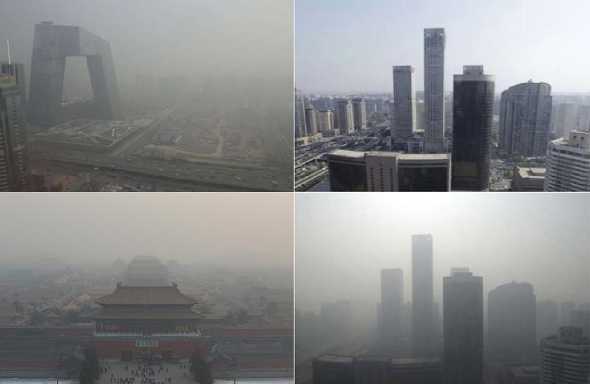
Figure 4. Smog in Beijing caused a large turmoil among the foreign population; therefore, local population had to pay high taxes on excessive emission of produced gases in order to temporarily improve the state due to upcoming Olympics at the time and China’s image in the world [30]
From this point of view, a small country such as our own can try to provide its contribution and to hope for the best. But, while looking at the wider picture, the nature is still ruthless and unappealing and it doesn’t make any choices, therefore, even though economically developed countries have a power of “rapid regeneration” of damaged parts, due to natural disasters, it cannot last forever. Economic resources are constantly expending and reparation seeks for large and constant separations. The best example of inability was shown on destruction of New Orleans (USA) in 2004, due to hurricane Katrina impact. Until today, a powerful country did not manage to remediate damages in the city.
Construction of Unique Buildings and Structures, 2015, №4 (31)
Spatial planning and urbanization
Is the fight over Earth’s resources exploitation in the aim of energy production, which is why the 20th and the 21st century – the stage of bloody wars, have made certain powerful financial lobbies to consider going in another direction and searching for new models of energy production from so called “pure” – green energy sources? As proven by scientist Nikola Tesla, the Earth is a great catalyst of electric energy. Energy is everywhere around us. It is clear that he invented the wireless energy transmission, it is clear that he pointed that the energy is all around us, but its lack of profitability at the time, prevented Nikola Tesla from drawing a route that would lead in a healthier direction, without coal, oil/petroleum and nuclear processes which clearly damage the planet Earth and its development. Does the human see a danger that emerges due to global climatic changes? But, what he causes, he can, also, correct. Shifting of Earth’s magnetic poles, Earth’s mass growth (theoretically, 200 million years ago, the Earth did not have seas and it was 40 times smaller in size), Solar activity (thermonuclear explosions, solar spots and their disappearance), processes on other planets of Solar system and thesis on existence of electric cosmos connected by strong magnetic forces lead to the fact that the Human, at this level of awareness, cannot affect them, but he will inevitably have to adjust. [5]
However, it is obvious on the other hand that humankind is numerically increasing. Nowadays, 72% of population lives in cities, and it is considered that the number of people will double (up to ten billion) until 2050 and 85% of the population will live in cities. Each one of these prognoses/predictions point out to the fact that humankind must rapidly transform the way of thinking and create new models for its sustainability.
Still, we must be ready for both options. All these actions lead to relevant changes both in the planning process and the construction of settlements. Due to changes in climate, all countries are searching for models of efficient construction, which helps in preservation of the environment through various shapes (e.g. LEED, BREEAM, HQE, DGNB, Green Star, and Standard for Construction of Green Buildings). That is the reason why this form of planning and construction, depending on the aspect from which is observed, can be found under different names, such as “green construction”, “sustainable architecture” or from financial point of view, “green economy”.
Certain financial circles have spotted that in this sphere, which is a pioneer in terms of economic exploitation, significant economic benefits may be accomplished. Both in theory and practice, this idea is positive, regardless of the fact that economic cost effectiveness is frequently set as a top priority in regard to the need for preservation of life quality which should be the first goal on the list to everyone who could make a difference. However, sustainable architecture that used to be a synonymous for luxury and close only to the rich, due to economic crisis and increased sensibility to energetic stability, has become significantly accessible because of the increase of awareness towards construction and life ecology.
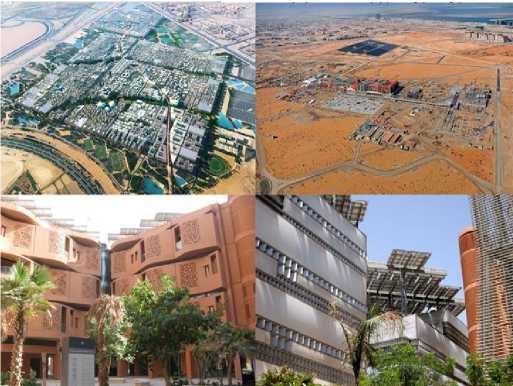
Figure 5. Norman Foster and partners have designed Masdar town in Abu Dhabi – town on 6 million square meters which is the first „zero-carbon and zero-waste“town in the world [31]
Sustainable architecture is the architecture, which integrates appropriate technologies, construction materials, while giving priorities to specified goals in designing and shaping of energy efficiency, reduction of impacts to the environment and all for the purpose of improvement of health and life quality for a user i.e. human, it seeks to minimize the negative environmental impact of buildings by efficiency and moderation in the use of materials, energy, and development space. The idea of sustainability, or ecological design, is to ensure that our actions and decisions today do not inhibit the opportunities of future generations.
Each building’s efficiency is considered to be successful if the building produces, i.e. restores a minimum of 30% of energy. But, buildings which practically produce 100% of energy needs exist now, and pollution is reduced to zero, therefore, those are the building of sustainable architecture.
Sustainable architecture: world’s achievements and outlooks
Ken Yeang is an early pioneer of ecology-based green design and masterplanning, carrying out design and research in this field since 1971. He was named by the Guardian as "one of the 50 people who could save the planet» [35]
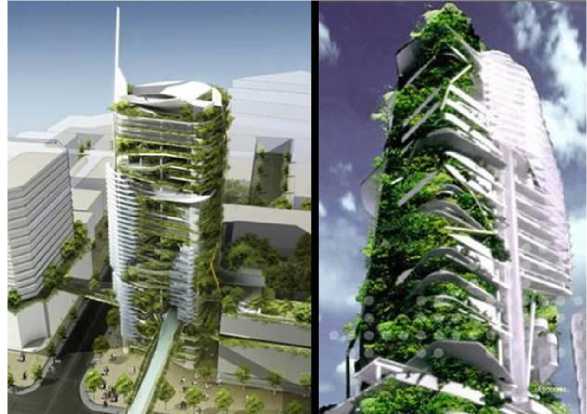
Figure 5a. EDITT Tower. 26-story high-rise building in Singapore and Solaris, Singapore
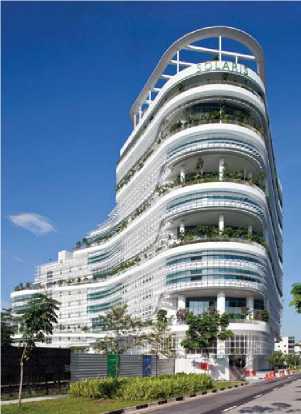
During the last decade, a plenty of sustainable architecture projects were implemented by engineers and scientists all over the world
These considerations lie in the base of many experiments in modern building construction, aimed at creating innovative “green” buildings. One of the interesting methods – use of various recycled waste as a building material. One of the most brightest and vivid example of a such innovative approach is the Brighton Waste House building, which consists of recycled and non-recycled garbage by 85%. Despite this, the building is quite energy efficient at the same time doesn’t require any significant costs for inner heating and doesn’t emit a lot of heat outside also.
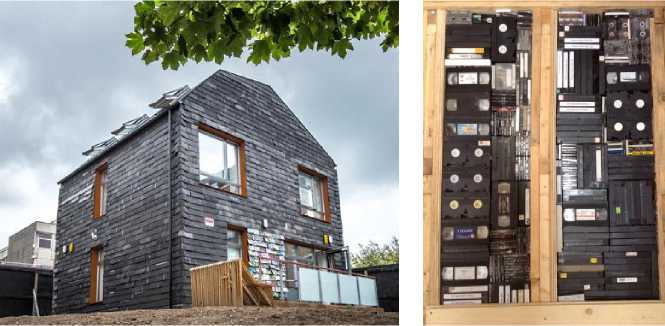
Figure 6. Brighton Waste House, made by Duncan Baker-Brown and his students from the University of Brighton in a year and example of the inner filling of the walls in Brighton Waste House [32]
Of course, the constructions made of garbage are an interesting, but not the only possible solution for making sustainable architecture buildings. Another method is directed to the integration of plants in the construction and their direct participation in the architecture of a building. For example, the Structural Technology Group of Universitat Politècnica de Catalunya – BarcelonaTech(UPC) has created the “bio-concrete”, the surface layer of which is favorable for the growth of some plants, though the inner layer possesses just the same properties, which a common high-strength concrete has. This solution has numerous benefits, environmental friendly and aesthetic facade absorbs CO2, which is excreted in the downtown, also such building has a high level of energy efficiency. This "green" facade protects the building from overheating in summer, delaying the sun's rays, as well as the cooling in the winter, delaying heat going through the exterior walls.

Figure 8. Example of using the bio-concrete in a real life [33]
So, there are many interesting developments that can help us fight greenhouse effect and improve our life quality, and even save our money as well. Nowadays, there are many private houses in Europe and USA, that produce 100% of energy needs and even more, so they can sell the energy surplus to the power plants. For example, ArchiBlox Positive House in Melbourne is the first precast energy positive building which produces more energy that needs itself.
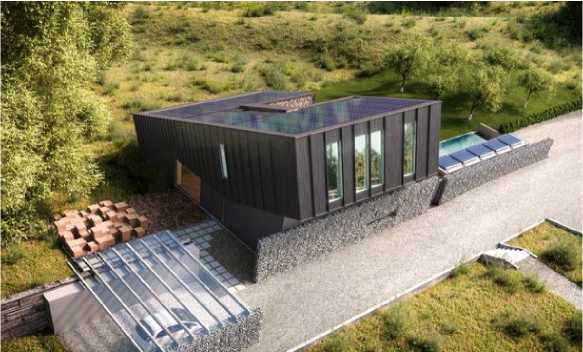
Figure 9. ZEB (Zero Emission Building) Pilot House in Norway [34]
Many innovations in construction sphere were created during the last decade, and even more are developing at this time. The main problem is to integrate innovations to the publicly available wide spread building construction, so these ecological-positive developments had a real impact on the environment, by reducing their cost and with the active participation of the governments of different countries.
Conclusion
In order to provide existence of sustainable architecture, sustainable planning must exist, as well. Each citizen’s aim should be reduction of all pollutions to the minimum, in order to maintain and improve the life on the planet. Positive intent should be the guide, and will it result in a successful outcome, time will tell as the best indicator. It is of crucial relevance to provide the acceptance and implementation of this initiative in small economic systems and countries, as well. The fact is that “small countries” must not wait, on the contrary, rapid actions on adoption of regulations on sustainable planning and architecture must be taken on one hand, and on tempting financial terms/conditions (taxes, fees) regarding technological and innovative achievements, on the other hand. Analysis shows that value of these areas and buildings is taking an upward trajectory. If we really want to listen to the “inner self” and innate instinct for survival and if we want to feel the love of the gift of life and nature, while removing economic benefits, politically “clever” decisions and strategic moves from this equation, we are only left with the words of a young lady Severn Suzuki, who addressed the world on behalf of ECO (Environmental Children’s Organization) and silenced it long enough that it can hear its own guilty conscience.
Список литературы World ecological problems and their solutions by the sustainable architecture
- Church, J.A., White, N.J., Coleman, R., Lambeck, K., Mitrovica, J.X. Estimates of the regional distribution of sea-level rise over the 1950 to 2000 period (2004) Journal of Climate 17(13) pp. 2609-2625.
- Serreze, M.C., Francis, J.A. The Arctic amplification debate (2006) Climate Change, pp. 241-264.
- Kelley, J.J. Carbon dioxide in the surface waters of the North Atlantic and the Barents and Kara Sea (1970) Limnology and Oceanography, 15 pp. 80-87
- Komatina, D. The development of settlements in the "small" countries due to climate change-induced economic developed countries. (2011) Future development of the settlement in light of climate change, pp. 113-122.
- Rosentrater, L. Evidence and Implications of Dangerous Climate Change in the Arctic WWF International Arctic Programme, (2005), 274 p.
- Caldeira, K., Wickett, M.E. Anthropogenic carbon and ocean pH (2003) Nature, pp. 365-365.
- Seiz, G., Foppa, N. The activities of the World Glacier Monitoring Service (WGMS) (2007) 174 p.
- Grudziński, Z. Koszty środowiskowe wynikające z użytkowania węgla kamiennego w energetyce zawodowej (2013) Rocznik Ochrona Środowiska (Annual Set The Environment Protection), 15, pp. 2249-2266
- Dąbrowski, J., Dąbrowski, T., Piecuch, T. Laboratory Studies on the Effectiveness of NOx Reduction by Selective Catalytic Reduction SCR Method (2013) Rocznik Ochrona Środowiska (Annual Set The Environment Protection), 15, pp. 301-313
- The Kyoto Protocol along with United Nations Framework Convention on Climate Change, international agreement, Kyoto, (2005)
- Heim D. Isothermal storage of solar energy in building construction (2010) Renewable Energy, 35(4), pp. 788-796.
- Szokolay S. V. Solar Energy in Buildings (2003) Reference Module in Earth Systems and Environmental Sciences (Encyclopedia of Physical Science and Technology (Third Edition)), pp. 111-126.
- Tsalikis G., Martinopoulos G. Solar Energy systems potential for nearly net zero energy residential buildings (2015) Solar Energy, 115, pp. 743-756.
- Perini K., Ottelé M., Fraaij A. L. A., Haas E.M., Raiteri R. Vertical greening systems and the effect on air flow and temperature on the building envelope (2011) Building and Environment, 46(11), pp. 2287-2294.
- Susorova I. Green facades and living walls: vertical vegetation as a construction material to reduce building cooling loads (2015) Eco-Efficient Materials for Mitigating Building Cooling Needs (Design, Properties and Applications), pp. 127-153.
- Rajput D., Bhagade S. S., Raut S. P., Ralegaonkar R. V., Mandavgane S. A. Reuse of cotton and recycle paper mill waste as building material (2012) Construction and Building Materials, 34, pp. 470-475.
- Cossu R. Waste and building materials: What type of articles should be submitted to Waste Management? (2010) Waste Management, 30(5), pp. 735-736.
- Sutcu M., Alptekin H., Erdogmus E., Er Y., Gencel O. Characteristics of fired clay bricks with waste marble powder addition as building materials (2015) Construction and Building Materials, 82, pp. 1-8.
- Zhou Y. State power and environmental initiatives in China: Analyzing China’s green building program through an ecological modernization perspective (2015) Geoforum, 61, pp. 1-12.
- Kareiva P. Ecological scenario building guides policy in North America (2001) Trends in Ecology & Evolution, 16(9), pp. 487.
- Joly M. P. Towards accessible sustainable architecture, source of autonomy (2011) Annals of Physical and Rehabilitation Medicine, 54, pp. 58.
- Krishan A., Jain K., Tewari P. Process of design for sustainable architecture and contemporary solutions (1998) Renewable Energy, 15(1-4), pp. 407-412.
- Huseynov E. F. Planning of sustainable cities in view of green architecture (2011) Procedia Engineering, 21, pp. 534-542.
- Wang X., Liu Z., Shang Y. Sustainable Analysis Architecture and Optimization of Urban Freight under Congestion (2014) Procedia -Social and Behavioral Sciences, 138, pp. 418-426.
- Niroumand H., Zain M. F. M., Jamil M. A guideline for assessing of critical parameters on Earth architecture and Earth buildings as a sustainable architecture in various countries (2013) Renewable and Sustainable Energy Reviews, 28, pp. 130-165.
- Dylewski R., Adamczyk J. Economic and ecological indicators for thermal insulating building investments (2012) Energy and Buildings, 54, pp. 88-95.
- Bin G., Parker P. Measuring buildings for sustainability: Comparing the initial and retrofit ecological footprint of a century home -The REEP House (2012) Applied Energy, 93, pp. 24-32.
- Niroumand H., Zain M. F. M., Jamil M., Niroumand S. Earth Architecture from Ancient until Today (2013) Procedia -Social and Behavioral Sciences, 89, pp. 222-225.
- Ngowi A. B. Creating competitive advantage by using environment-friendly building processes (2001) Building and Environment, 36(3), pp. 291-298.
- Smog in Beijing. URL: http://www.citylab.com and www.cnn.com (Date of reference 20.04.15)
- Masdar town in Abu Dhabi by Norman Foster. URL: http://www.fosterandpartners.com (Date of reference 20.04.15)
- Brighton Waste House by Duncan Baker-Brown. URL: http://www.dezeen.com/2014/06/19/waste-house-by-bbm-architects-is-uks-first-permanent-building-made-from-rubbish (Date of reference 23.04.15)
- Example of using the bio-concrete in a real life. URL: http://www.archdaily.com/315453/biological-concrete-for-a-living-breathing-facade (Date of reference 23.04.15)
- ZEB (Zero Emission Building) Pilot House in Norway. URL: http://www.designboom.com/architecture/snohetta-zeb-pilot-house-08-28-2014/(Date of reference 23.04.15)
- The Guardian. URL: http://www.theguardian.com/environment/2008/jan/05/activists.ethicalliving (Date of reference 20.04.15)

